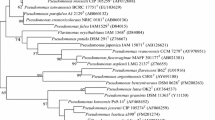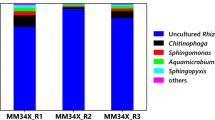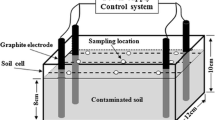Abstract
Considerable efforts that isolate and characterize degrading bacteria for polycyclic aromatic hydrocarbons (PAHs) have focused on contaminated environments so far. Here we isolated three distinctive pyrene (PYR)-degrading bacteria from a paddy soil that was not contaminated with PAHs. These included a novel Bacillus sp. PyB-9 and efficient degraders, Shigella sp. PyB-6 and Agromyces sp. PyB-10. All three strains could utilize naphthalene, phenanthrene, anthracene, fluoranthene and PYR as sole carbon sources, and degraded PYR in a range of temperatures (27–37 °C) and pH (5–8). Strains PyB-6 and PyB-10 almost completely degraded 50 mg L−1 PYR within 15 days, and 75.5% and 98.9% of 100 mg L−1 PYR in 27 days, respectively. The kinetics of PYR biodegradation was well represented by the Gompertz model. Ten and twelve PYR metabolites were identified in PYR degradation process by strains PyB-6 and PyB-10, respectively. Chemical analyses demonstrated that the degradation mechanisms of PYR were the same for strains PyB-6 and PyB-10 with initial dioxygenation mainly on C-4,5 positions of PYR. The degradation of 4,5-phenanthrenedicarboxylic acid was branched to 4-phenanthrenecarboxylic acid pathway and 5-hydroxy-4-phenanthrenecarboxylic acid pathway, both of which played important roles in PYR degradation by strains PyB-6 and PyB-10. To our knowledge, Shigella sp. and Agromyces sp. were found for the first time to possess the capability for PAHs degradation. These findings contributed to upgrading the bank of microbial resource and knowledge on PAH biodegradation.






Similar content being viewed by others
References
Buchanan RE, Gibbons NE (1975) Bergey’s manual of determinative bacteriology, 8th edn. Williams and Wilkins, Baltimore
Carlini C, Chaudhuri S, Mann O, Tomsik D, Hüffer T, Greggio N, Marazza D, Hofmann T, Sigmund G (2023) Benchmarking biochar with activated carbon for immobilizing leachable PAH and heterocyclic PAH in contaminated soils. Environ Pollut 325:121417. https://doi.org/10.1016/j.envpol.2023.121417
Cheng XY, Liu WW, Xu Y, Zhou YN (2019) Screening and characterization of culturable hydrocarbon-degrading strains from the South and East China Seas. Microbiol China 46:975–985
Debruyn JM, Mead TJ, Wilhelm SW, Sayler GS (2009) PAH biodegradative genotypes in Lake Erie sediments: evidence for broad geographical distribution of pyrene-degrading Mycobacteria. Environ Sci Technol 43:3467–3473
Galkiewicz JP, Kellogg CA (2008) Cross-kingdom amplification using bacteria specific primers: complications for studies of coral microbial ecology. Appl Environ Microbiol 74:7828–7831. https://doi.org/10.1128/AEM.01303-08
Gerhardt P, Murray R, Wood WA, Krieg NR (1994) Methods for general and molecular bacteriology. American Society for Microbiology, Washington
Ghosh I, Jasmine J, Mukherji S (2014) Biodegradation of pyrene by a Pseudomonas aeruginosa strain RS1 isolated from refinery sludge. Bioresour Technol 166:548–558. https://doi.org/10.1016/j.biortech.2014.05.074
Gu HP, Lou J, Wang HZ, Yang Y, Wu LS, Wu JJ, Xu JM (2016) Biodegradation, biosorption of phenanthrene and its trans-membrane transport by Massilia sp. WF1 and Phanerochaete chrysosporium. Front Microbiol. https://doi.org/10.3389/fmicb.2016.00038
Hennessee CT, Li QX (2016) Effects of PAH mixtures on degradation, gene expression, and metabolite production in four Mycobacterium species. Appl Environ Microbiol 82:3357–3369. https://doi.org/10.1128/AEM.00100-16
Heyrman J, Vanparys B, Logan NA, Balcaen A, Rodríguez-Díaz M, Felske A, De Vos P (2004) Bacillus novalis sp. nov. Bacillus vireti sp. nov. Bacillus soli sp. nov. Bacillus bataviensis sp. nov. and Bacillus drentensis sp. nov. from the Drentse A grasslands. Int J Syst Bacteriol 54:47–57. https://doi.org/10.1099/ijs.0.02723-0
Hong WJ, Jia HL, Ma WL, Sinha RK, Moon HB, Nakata H, Minh NH, Chi KH, Li WL, Kannan K, Sverko E, Li YF (2016) Distribution, fate, inhalation exposure and lung cancer risk of atmospheric polycyclic aromatic hydrocarbons in some Asian countries. Environ Sci Technol 50:7163–7174. https://doi.org/10.1021/acs.est.6b01090
Jones MD, Crandell DW, Singleton DR, Aitken MD (2011) Stable-isotope probing of the polycyclic aromatic hydrocarbon-degrading bacterial guild in a contaminated soil. Environ Microbiol 13:2623–2632. https://doi.org/10.17615/4avm-9r37
Jurado V, Groth I, Gonzalez JM, Laiz L, Schuetze B, Jimenez CS (2005) Agromyces italicus sp. nov., Agromyces humatus sp. nov. and Agromyces lapidis sp. nov., isolated from Roman catacombs. Int J Syst Evol Microbiol 55:871–875. https://doi.org/10.1099/ijs.0.63414-0
Karn SK, Balda S (2013) Bioremediation 2,4,6,-trichlorophenol (2,4,6-TCP) by Shigella sp. S2 isolated from industrial dumpsite. Bioremediat J 17:71–78. https://doi.org/10.1080/10889868.2012.751959
Kim YH, Freeman JP, Moody ID, Engesser KH, Cerniglia CE (2005) Effects of pH on the degradation of phenanthrene and pyrene by Mycobacterium vanbaalenii PYR-1. Appl Microbiol Biotechnol 67:275–285. https://doi.org/10.1007/s00253-004-1796-y
Kim SJ, Kweon O, Jones RC, Freeman JP, Edmondson RD, Cerniglia CE (2007) Complete and integrated pyrene degradation pathway in Mycobacterium vanbaalenii PYR-1 based on systems biology. J Bacteriol 189:464–472. https://doi.org/10.1128/jb.01310-06
Li JB, Zhang DY, Li B, Luo CL, Zhang G (2022) Identifying the active phenanthrene degraders and characterizing their metabolic activities at the single-cell level by the combination of magnetic-nanoparticle-mediated isolation, stable-isotope probing, and raman-activated cell sorting (MMI-SIP-RACS). Environ Sci Technol 56:2289–2299. https://doi.org/10.1021/acs.est.1c04952
Liang JD, Gao S, Wu ZJ, Rijnaarts HHM, Grotenhuis T (2021) DNA-SIP identification of phenanthrene-degrading bacteria undergoing bioaugmentation and natural attenuation in petroleum-contaminated soil. Chemosphere 266:128984. https://doi.org/10.1016/j.chemosphere.2020.128984
Liu H, Yang C, Tian Y, Lin G, Zheng TL (2011) Using population dynamics analysis by DGGE to design the bacterial consortium isolated from mangrove sediments for biodegradation of PAHs. Int Biodeterior Biodegradation 65:269–275. https://doi.org/10.1016/j.ibiod.2010.11.010
Logan NA, Berkeley RCW (1984) Identification of Bacillus strains using the API system. J Gen Microbiol 130:1871–1882. https://doi.org/10.1099/00221287-130-7-1871
Logan NA, Lebbe L, Hoste B, Goris J, Forsyth G, Heyndrickx M, Murray BL, Syme N, Wynn-Williams DD, De Vos P (2000) Aerobic endospore-forming bacteria from geothermal environments in northern Victoria Land, Antarctica, and Candlemas Island, South Sandwich archipelago, with the proposal of Bacillus fumarioli sp. nov. Int J Syst Bacteriol 50:1741–1753. https://doi.org/10.1099/00207713-50-5-1741
Luan TG, Yu KS, Zhong Y, Zhou HW, Lan CY, Tam NF (2006) Study of metabolites from the degradation of polycyclic aromatic hydrocarbons (PAHs) by bacterial consortium enriched from mangrove sediments. Chemosphere 65:2289–2296. https://doi.org/10.1016/j.chemosphere.2006.05.013
Ma J, Xu L, Jia L (2013) Characterization of pyrene degradation by Pseudomonas sp. strain Jpyr-1 isolated from active sewage sludge. Bioresour Technol 140:15–21. https://doi.org/10.1016/j.biortech.2013.03.184
Mai ZM, Wang L, Li QQ, Sun YT, Zhang S (2021) Biodegradation and metabolic pathway of phenanthrene by a newly isolated bacterium Gordonia sp. SCSIO19801. Biochem Bioph Res Co 585:42–47. https://doi.org/10.1016/j.bbrc.2021.10.069
Maliszewska-Kordybach B (1996) Polycyclic aromatic hydrocarbons in agricultural soils in Poland: preliminary proposals for criteria to evaluate the level of soil contamination. Appl Geochem 11:121–127. https://doi.org/10.1016/0883-2927(95)00076-3
Nagel M, Andreesen JR (1991) Bacillus niacini sp. nov. a nicotinate-metabolizing mesophile isolated from soil. Int J Syst Bacteriol 41:134–139. https://doi.org/10.1099/00207713-41-1-134
Nguyen NL, Kim YJ, Hoang VA, Min JW, Yang DC (2013) Bacillus ginsengisoli sp. nov. isolated from soil of a ginseng field. Int J Syst Bacteriol 63:855–860. https://doi.org/10.1099/ijs.0.031740-0
Ortiz I, Auria R, Sigoillot JC, Revah S (2003) Enhancing phenanthrene biomineralization in a polluted soil using gaseous toluene as a cosubstrate. Environ Sci Technol 37:805–810. https://doi.org/10.1021/es0260061
Ren GD, Teng Y, Ren WJ, Dai SX, Li ZG (2016) Pyrene dissipation potential varies with soil type and associated bacterial community changes. Soil Biol Biochem 103:71–85. https://doi.org/10.1016/j.soilbio.2016.08.007
Sharma M, Salama ES, Usman M, Khan A, Arif M, Li XK (2023) Evaluation of aerobic biodegradation of phenanthrene using Pseudomonas turukhanskensis: an optimized study. Biodegradation 34:21–41. https://doi.org/10.1007/s10532-022-10002-5
Su WQ, Yu MJ, Lin JH, Tang CC, Xu JM (2022) Fire decreases gross mineralization rate but does not alter gross nitrification rate in boreal forest soils. Soil Bio Biochem 175:108838. https://doi.org/10.1016/j.soilbio.2022.108838
Subashchandrabose SR, Venkateswarlu K, Naidu R, Megharaj M (2019) Biodegradation of high-molecular weight PAHs by Rhodococcus wratislaviensis strain 9: overexpression of amidohydrolase induced by pyrene and BaP. Sci Total Environ 651:813–821. https://doi.org/10.1016/j.scitotenv.2018.09.192
Sun SS, Wang HZ, Chen YZ, Lou J, Wu LS, Xu JM (2019) Salicylate and phthalate pathways contributed differently on phenanthrene and pyrene degradations in Mycobacterium sp. WY10. J Hazard Mater 364:509–518. https://doi.org/10.1016/j.jhazmat.2018.10.064
Sun SS, Wang HZ, Fu BX, Zhang H, Lou J, Wu LS, Xu JM (2020) Non-bioavailability of extracellular 1-hydroxy-2-naphthoic acid restricts the mineralization of phenanthrene by Rhodococcus sp. WB9. Sci Total Environ 704:135331. https://doi.org/10.1016/j.scitotenv.2019.135331
Talukder KA, Aminul Islam M, Dutta DK, Hassan F, Safa A, Nair GB, Sack DA (2002) Phenotypic and genotypic characterization of serologically typical strains of Shigella flexneri type 4 isolated in Dhaka, Bangladesh. J Clin Microbiol 40:2490–2497. https://doi.org/10.1128/JCM.40.7.2490-2497.2002
Tang L, Bao ZK, Zhao XQ, Wang XB, Gao YZ, Lu C, Ling WT (2023) Variations of different PAH fractions and bacterial communities during the biological self-purification in the soil vertical profile. J Hazard Mater 458:131903. https://doi.org/10.1016/j.jhazmat.2023.131903
Vila J, López Z, Sabaté J, Minguillón C, Solanas AM, Grifoll M (2001) Identification of a novel metabolite in the degradation of pyrene by Mycobacterium sp. strain AP1: actions of the isolate on two- and three-ring polycyclic aromatic hydrocarbons. Appl Environ Microbiol 67:5497–5505. https://doi.org/10.1128/AEM.67.12.5497-5505.2001
Wanapaisan P, Laothamteep N, Vejarano F, Chakraborty J, Shintani M, Muangchinda C, Morita T, Minakuchi CS, Inoue K, Nojiri H, Pinyakong O (2018) Synergistic degradation of pyrene by five culturable bacteria in a mangrove sediment-derived bacterial consortium. J Hazard Mater 342:561–570. https://doi.org/10.1016/j.jhazmat.2017.08.062
Wang RF, Cao WW, Cerniglia CE (1997) Phylogenetic analysis and identification of Shigella spp. by molecular probes. Mol Cell Probes 11:427–432. https://doi.org/10.1006/mcpr.1997.0136
Wang HZ, Lou J, Gu HP, Luo XY, Yang L, Wu LS, Liu Y, Wu JJ, Xu JM (2016) Efficient biodegradation of phenanthrene by a novel strain Massilia sp. WF1 isolated from a PAH-contaminated soil. Environ Sci Pollut Res 23:13378–13388. https://doi.org/10.1007/s11356-016-6515-6
Wang WP, Wang L, Shao ZZ (2018) Polycyclic aromatic hydrocarbon (PAH) degradation pathways of the obligate marine PAH degrader Cycloclasticus sp. Strain P1. Appl Environ Microbiol 84:e01261-e1318. https://doi.org/10.1128/AEM.01261-18
Wang JF, Zhang H, Cai J, Li J, Sun BH, Wu FY (2023) Effects of different carbon substrates on PAHs fractions and microbial community changes in PAHs-contaminated soils. Environ Pollut 324:121367. https://doi.org/10.1016/j.envpol.2023.121367
Wei R, Ni JZ, Guo L, Yang LM, Yang YS (2014) The effect of aging time on the distribution of pyrene in soil particle-size fractions. Geoderma 232–234:19–23. https://doi.org/10.1016/j.geoderma.2014.04.027
Wei R, Ni JZ, Li XY, Chen WF, Yang YS (2017) Dissipation and phytoremediation of polycyclic aromatic hydrocarbons in freshly spiked and long-term field-contaminated soils. Environ Sci Pollut Res 24:7994–8003. https://doi.org/10.1007/s11356-017-8459-x
Woodward DL, Clark CG, Caldeira RA, Ahmed R, Soule G, Bryden L, Tabor H, Melito P, Foster R, Walsh J, Ng LK, Malcolm GB, Strockbine N, Rodgers FG (2005) Identification and characterization of Shigella boydii 20 serovar nov. a new and emerging Shigella serotype. J Med Microbiol 54:741–748. https://doi.org/10.1099/jmm.0.46095-0
Zhao HP, Wu QS, Wang L, Zhao XT, Gao HW (2009) Degradation of phenanthrene by bacterial strain isolated from soil in oil refinery fields in Shanghai China. J Hazard Mater 164:863–869. https://doi.org/10.1016/j.jhazmat.2008.08.098
Acknowledgements
The authors are grateful to the financial support by the National Natural Science Foundation of China (42077130, 40971265).
Funding
Funding was provided by National Natural Science Foundation of China (Grant No. 42077130, 40971265).
Author information
Authors and Affiliations
Contributions
SS: Writing-original draft, Formal analysis, Investigation. RW: Conceptualization, Writing-review and editing. SH: Investigation, Methodology. MY: Data curation, Validation. JN: Writing-review and editing, Supervision, Funding acquisition.
Corresponding author
Ethics declarations
Competing interests
The authors declare no competing interests.
Additional information
Publisher's Note
Springer Nature remains neutral with regard to jurisdictional claims in published maps and institutional affiliations.
Supplementary Information
Below is the link to the electronic supplementary material.
Rights and permissions
Springer Nature or its licensor (e.g. a society or other partner) holds exclusive rights to this article under a publishing agreement with the author(s) or other rightsholder(s); author self-archiving of the accepted manuscript version of this article is solely governed by the terms of such publishing agreement and applicable law.
About this article
Cite this article
Sun, S., Wei, R., Hu, S. et al. Isolation and characterization of distinctive pyrene-degrading bacteria from an uncontaminated soil. Biodegradation (2024). https://doi.org/10.1007/s10532-023-10065-y
Received:
Accepted:
Published:
DOI: https://doi.org/10.1007/s10532-023-10065-y




